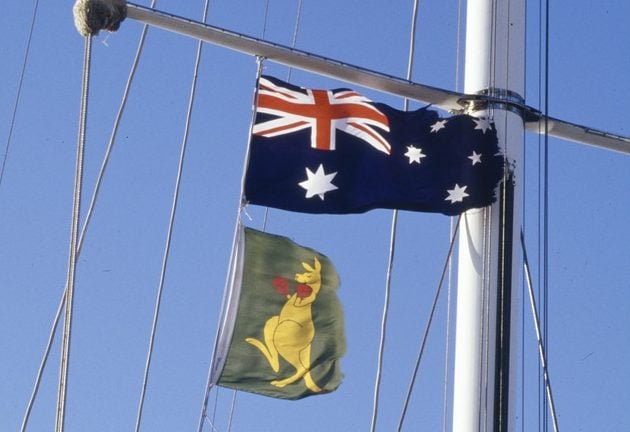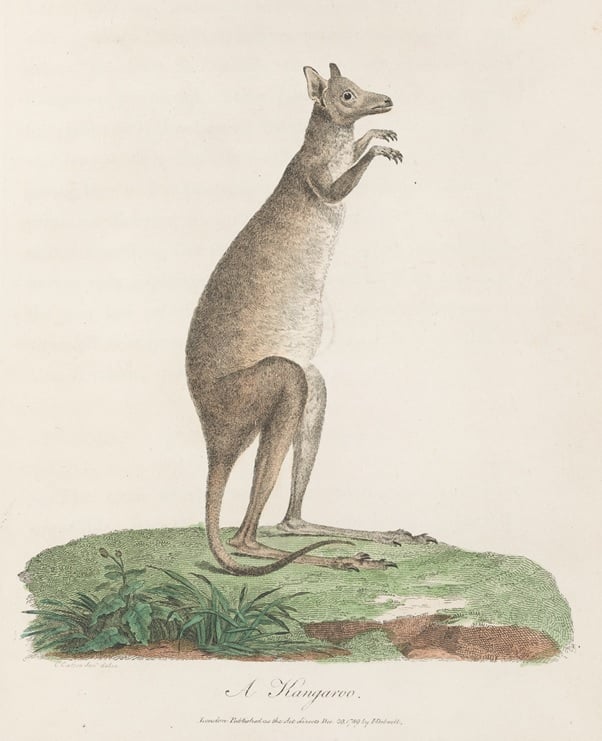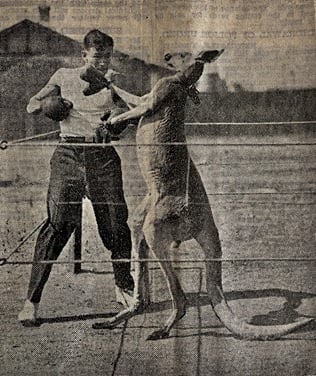The image of the boxing kangaroo – complete with boxing gloves – is one that dominates many people’s perceptions of this iconic Australian animal. It is an enduring national symbol, featuring on Royal Australian Air Force (RAAF) planes during the Second World War, as well as being a popular national sporting symbol.
Not everyone would know of the historical origins of this familiar symbol.
![N-Nuts: Boxing kangaroo with joey punching Hitler, row of bombs alongside, letters PON painted on nose of plane [Emblems on R.A.A.F. Squadron aircraft in the R.A.F. during World War II ca. 1943-45]; H2000.200/1809-1827](https://blogs.slv.vic.gov.au/wp-content/uploads/2018/11/Emblems-on-R.A.A.F.-Squadron-aircraft-in-the-R.A.F.-during-World-War-II.jpg)
Boxing kangaroo with joey punching Hitler, row of bombs alongside, painted on nose of RAAF Squadron aircraft, ca 1943–45.

Boxing kangaroo symbol made famous by Bond’s America’s Cup win, 1987; H2012.113/206. Photo by Rennie Ellis. This item is in copyright.
Recently I had a query from a patron about a kangaroo called Darcy – so named after boxing legend Les Darcy – who apparently toured regional parts of Victoria in the 1930s, boxing human opponents as part of an outback travelling show.
I turned to the digitised newspapers on the National Library of Australia’s fantastic Trove database to see if I could unearth any mention of this boxing kangaroo. Unfortunately, Darcy proved to be elusive, but I did find numerous references to other notable boxing kangaroos. It became clear that these kangaroos were common spectacles in Australia from the late nineteenth century well into the twentieth century.
My newspaper searches found Peter (the ‘pet who packed a punch!’), Jo-Jo (a ‘world champion’ who sparred with the Italian heavyweight Primo Carnera in Atlantic City), and Aussie from South Australia who ended up becoming a very popular attraction in London.
In 1931, the Sydney Mail reported:
‘Aussie was caught as a joey after a two mile chase by Mr. W. Fabre, who trained him with boxing gloves to such good purpose that the pupil soon developed the habit of knocking out his master.’ [1]
Aussie was to became a sensation on the London vaudeville stage, performing twice daily at the Westminster Aquarium until 1935 when a London correspondent sadly reported that Aussie had retired from the ‘ring’.
‘He will dwell at the London Zoo. Aussie has been a professional boxer for nine years, but he contracted arthritis in the tail. All sorts of cures were tried, but in vain. Aussie’s owner decided to present him to the Zoological Gardens where the experts still hope to effect a cure, but any case, the kangaroo’s boxing days are over. In future. Aussie will be a pensioner.’ [2]
Kangaroos had aroused curiosity abroad much earlier than Aussie’s time.

A Kangaroo, 1789, engraving by Charles Catton from Journal of a voyage to New South Wales by John White; 30328102131496
Governor Phillip sent the first kangaroo to England in 1791. In a despatch sent to Lord Grenville by Phillip November 22:
‘My Lord, – The commander of the armed tender Supply has an animal in charge which is known in England by the name of kangaroo, and which I hope will live to be delivered to your lordship for the purpose of being sent to his Majesty. I have taken the liberty as it is not known that any animal of the kind has been sent to England.’ [3]
Indigenous Australians have long utilised kangaroos for food, clothing and tools, and paid respect to them through story, ceremony and art in an association that has lasted millennia. [4] To the European settlers confronting kangaroos for the first time, the kangaroo was a bewildering and fascinating creature.
Colonists noted the defensive manoeuvres which male kangaroos adopted against each other in the wild, and likened the way they used their forearms to hold their assailant in place in order to kick and slash at them with their powerful hind legs to ‘boxing’.
![[Encounter with a kangaroo near Benalla]. Engraving by Samuel Calvert; IAN28/01/74/8](https://blogs.slv.vic.gov.au/wp-content/uploads/2018/11/Encounter-with-a-kangaroo-near-Benalla.jpg)
Encounter with a kangaroo near Benalla, engraving by Samuel Calvert, published in The illustrated Australian news, 28 January 1874; IAN28/01/74/8
Entrepreneurs were to capitalise on this natural proclivity for ‘boxing’ by training and exhibiting trained kangaroos for entertainment purposes – a practice that would be condemned for its cruelty today but was enormously popular with colonial audiences.
Fighting Jack – a breakout star
One of the most famous of boxing kangaroos and the first poster boy for the ‘sport’ was ‘Fighting Jack’. Heralded as a ‘Marsupial Warrior’, Jack made his first public appearance with his human opponent and co-star, Professor Lendermann, in March 1891 at the Melbourne Waxworks, established in 1857.
‘Jack the Fighting Kangaroo has taken up his position as a public entertainer at the Waxworks, where he gives an exhibition of his warlike instincts every afternoon at three o’clock, and every evening at nine – his antagonist being Professor Lindermann… Jack’s history is so far remarkable, from his being the first of his species to voluntarily accept a regular course of training, and by so doing upsetting all the theories formulated by naturalists, who state that kangaroos cannot be educated.’ [5]

Melbourne Punch, 16 April 1891, p 7
‘Jack, the Fighting Kangaroo, engages in his glove contest with Professor Lindermann twice every day, and as both combatants share in the victory, there is no bad feeling between them. The kangaroo evidently feels pleased at the applause he receives, and, like other stars, feels hurt if he has to play – or fight – before a cold audience.’ [6]
Jack’s story is interesting from another point of view – as a case study of a married woman testing her colonial property rights under the New South Wales Married Women’s Property Act of 1879. [7] Contrary to reports that Fighting Jack was the business venture of Mr RS Mayne, his wife Olivia claimed that it was she who originally purchased Jack as a pet – with her own earnings as a ‘maker of fancy goods’, and ‘as a pastime, she taught the animal various tricks.’ [8]
Jack was so successful that Olivia struggled to manage him herself, and in July 1891 she signed him over to the MacMahon brothers (theatrical entrepreneurs James and Charles), who took Jack on a lucrative Australian tour.
Jack appeared at the Waxworks for 6 weeks before he headed to Adelaide, where crowds were just as enthusiastic about his performance as they were in Melbourne:
‘[W]hen Jack appears on stage he was heartily received. He did not appear at all disconcerted, but mildly licked his fore paws until his adversary appeared. Professor von Lindemann did not at once enter into an affray, but knelt down in front of the marsupial to be caressed. This terminated Professor von Lindemann sprang to his feet and commenced assaulting Jack about the head. The kangaroo took the blows calming for a time, coolly ducking his head to avert punishment, but one or two stiff clouts on the chest brought him up to his metal, and he stood up to his foe on the end of his tail and his hind legs, every now and then attempting to strike with his long claws … The whole time the animal was on stage the audience was kept in roars of laughter at the amusing manner in which he illustrated the feints and tricks of a boxer.’ [9]
A tour of the eastern coast of Australia commenced, including an acting role in a production of Evangeline, a burlesque show, in Sydney. It appears that the MacMahon brothers had designs to have Jack tour America, but unfortunately (and unsurprisingly) poor Jack did not lead a long life. On 3 November 1891 a Newcastle newspaper reported that Jack, ‘the ambitious young kangaroo pugilist’ (ie. professional boxer), had departed this life. [10]
An undeterred Professor Lindemann was soon touring again with another kangaroo named Jack. Jack the 2nd proved to be as short-lived as the first, and was replaced with John L (after the famous boxer John L Sullivan), who boxed Lindemann abroad to the delight of London audiences.
Kangaroo fever ensued and there were many boxing roos exhibited in the UK, America and even Europe, with Aussie being one of the most notable exports until arthritis put a stop to his boxing career.
Thankfully, the ‘sport’ eventually waned in popularity and the boxing kangaroo became instead the durable national symbol it is today, epitomising the Australian ‘have a go’ attitude and fighting spirit.

The Boxing Kangaroo: ‘Aussie’ is included in the cast of a show at London theatre, The Sydney Morning Herald, 3 December 1930, p 18
References
[1] Marsupial emigrants in England (1931, October 28), Sydney Mail (NSW), p 4
[2] In the papers (1935, January 5), The Argus (Melbourne, Vic), p 7
[3] Historical records of Australia, Series I, Governors’ despatches to and from England
[4] Jackson, Stephen, and Karl Vernes, Kangaroo: Portrait of an extraordinary marsupial, Allen & Unwin, 2011. Held in print and Victorian registered library members can access as an ebook.
[5] The waxworks. (1891, March 26) Table Talk (Melbourne, Vic), p 13
[6] The waxworks. (1891, April 3) Table Talk (Melbourne, Vic), p 13
[7] Williams, Margaret and Golder, Hilary. ‘Fighting Jack: a brief Australian melodrama’, Australasian Drama Studies, No 36, Apr 2000: 117–130. Held in print or Victorian registered library members can access online.
[8] Law report (1891, December 24), The Sydney Morning Herald (NSW: 1842–1954), p 3
[9] Amusements (1891, May 22) The Advertiser (Adelaide, SA), p 6
[10] Another victim of influenza (1891, November 3), Newcastle Morning Herald and Miners’ Advocate (NSW), p 5
Further reading
Colligan, Mimi. ‘Waxworks shows and some of their proprietors in Australia, 1850s–1910s’. Australasian Drama Studies, No 34, Apr 1999: 86–107. Held in print or Victorian registered library members can access online.
Golder, Hilary, and Diane Kirkby, ‘Mrs Mayne and her boxing kangaroo: A married woman tests her property rights in colonial New South Wales’, Law and History Review, Vol 21, No 3 (Autumn, 2003), pp 585-605, Victorian registered library members can access online.

![George Brien on horseback being attacked by an aggressive wild kangaroo, Wangaratta [ca. 1920 - 1930]; H2007.10/1 and H2007.10/2](https://blogs.slv.vic.gov.au/wp-content/uploads/2018/11/George.jpg)

Fantastic blog, Kylie! So fascinating to hear from where the symbol of the boxing kangaroo originated. It certainly was a cruel entertainment venture – reminiscent of dancing bears – but at least the poor kangaroos had the opportunity to give their captors a good whack in return!